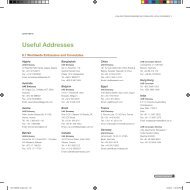Arab World Competitiveness Report 2011-2012 - World Economic ...
Arab World Competitiveness Report 2011-2012 - World Economic ...
Arab World Competitiveness Report 2011-2012 - World Economic ...
Create successful ePaper yourself
Turn your PDF publications into a flip-book with our unique Google optimized e-Paper software.
1. A Time of Opportunities: The <strong>Competitiveness</strong> Performance of the <strong>Arab</strong> <strong>World</strong><br />
<strong>Arab</strong> <strong>World</strong> <strong>Competitiveness</strong> <strong>Report</strong> <strong>2011</strong>-<strong>2012</strong><br />
20<br />
North Africa’s National <strong>Competitiveness</strong><br />
Assessment<br />
In early <strong>2011</strong>, most North African countries experienced<br />
a wave of social protests that impacted countries in<br />
different ways. While political transitions are now under<br />
way in Egypt, Tunisia, and Libya, Morocco and, to a<br />
lesser extent, Algeria have also embarked on political<br />
and economic reform programs. The uncertainty<br />
associated with these events inevitably has led to a<br />
short-term decline in economic and competitiveness<br />
performance for <strong>2011</strong> in the most affected countries.<br />
However, the political changes bring with them the<br />
opportunity to put into place competitiveness-enhancing<br />
measures that will enable countries to move towards a<br />
higher growth path quickly and to generate employment<br />
opportunities for their populations.<br />
While competitiveness has been high on the agenda of<br />
most economies over the past several years, progress<br />
across North Africa has been mixed. The economies of<br />
Egypt and Algeria have declined in the rankings, while<br />
Morocco and Tunisia have remained stable.<br />
Tunisia, the country where the <strong>Arab</strong> Spring began,<br />
maintains the lead as the by far most competitive<br />
economy in North Africa at 40th place overall. The<br />
popular uprising in the spring of <strong>2011</strong> was accompanied<br />
by a rise in uncertainty, and has brought to light<br />
a number of challenges related to the institutional<br />
environment, among others. These two developments<br />
resulted in a less favorable assessment of the quality<br />
of public and private institutions, which drops from<br />
23rd last year to 41st. There seems to be a greater<br />
recognition within the institutional framework of the<br />
prevalence of corruption and government favoritism,<br />
as well as concerns about the independence of the<br />
judiciary. Not surprisingly, the security situation – one of<br />
the country’s main competitive advantages in the past<br />
– is seen as more costly for business than in previous<br />
years (47th).<br />
However, the country’s core competitive strengths bode<br />
well for the future. First, Tunisia continues to display<br />
solid educational outcomes, which remain significantly<br />
above the North African average in terms of not only<br />
quality (33rd), but also participation at the primary<br />
and secondary levels (91.8 and 33.7 percent of the<br />
respective age groups) Second, the macroeconomic<br />
environment was traditionally maintained at a healthy<br />
state (38th in 2010), so the country’s new government<br />
will benefit from manageable levels of public debt that<br />
will not significantly constrain investment in the future.<br />
Despite these strengths, the economic agenda is<br />
challenging. Political leaders must not lose sight of the<br />
long-term picture. Providing the country’s youth with<br />
employment opportunities in the future will require not<br />
only stronger and more transparent institutions and a<br />
more meritocratic business culture, but also a business<br />
environment that is more conducive to vibrant and<br />
healthy competition. Such an environment requires<br />
reducing domestic barriers to market entry – presently<br />
constrained by red tape and high taxes (107th and<br />
122nd, respectively) – and lowering import tariffs. Some<br />
of the measures enacted by the interim government aim<br />
at fighting corruption and undue influence and will raise<br />
the country’s competitiveness in the future.<br />
Placing 73rd in the GCI, Morocco is consolidating<br />
its position. The country’s strong macroeconomic<br />
fundamentals balance out some pronounced<br />
competitive weaknesses in other areas. A low fiscal<br />
deficit (1.8 percent of GDP in 2010), a favorable<br />
interest rate spread (18th), and low inflation (1 percent)<br />
contribute to a stable and predictable business<br />
environment. Likewise, some aspects of the institutional<br />
framework are assessed rather positively, such as public<br />
trust in politicians (48th) and the degree of government<br />
favoritism (46th). Morocco has made important progress<br />
in terms of reducing red tape when creating enterprises<br />
(34th for number of procedures to start a business) and<br />
reducing the burden of customs procedures (49th).<br />
Additional reforms were implemented in 2010 and <strong>2011</strong><br />
to facilitate administrative procedures related to the<br />
functioning of enterprises.<br />
According to the GCI, challenges persist in two areas<br />
that are important not only for competitiveness, but also<br />
for social cohesion in the country – education and the<br />
efficiency of labor markets. Education systems across<br />
all levels need improvement. Access to education is less<br />
prevalent than in other countries from the region, with<br />
enrolment rates for secondary and tertiary education<br />
remaining low (112th and 101st, respectively). At the<br />
same time, curricula and teaching methods are not<br />
aligned sufficiently with the needs of business (93rd).<br />
One positive aspect is the prevalence of on-the-job<br />
training (58th), which certainly has the potential to<br />
compensate for some shortcomings in the educational<br />
system. Yet, for education to translate into higher<br />
productivity, labor market structure must allow for an<br />
efficient use of talent and sufficient flexibility. This is<br />
currently not the case in Morocco, where labor market<br />
efficiency is assessed at 132nd overall. Labor market<br />
regulations are rigid with respect to the hiring process<br />
and wage setting, and meritocracy is not prevalent<br />
among management. Last but not least, the potential<br />
of the female labor force for productivity improvement is<br />
underused (134th).





